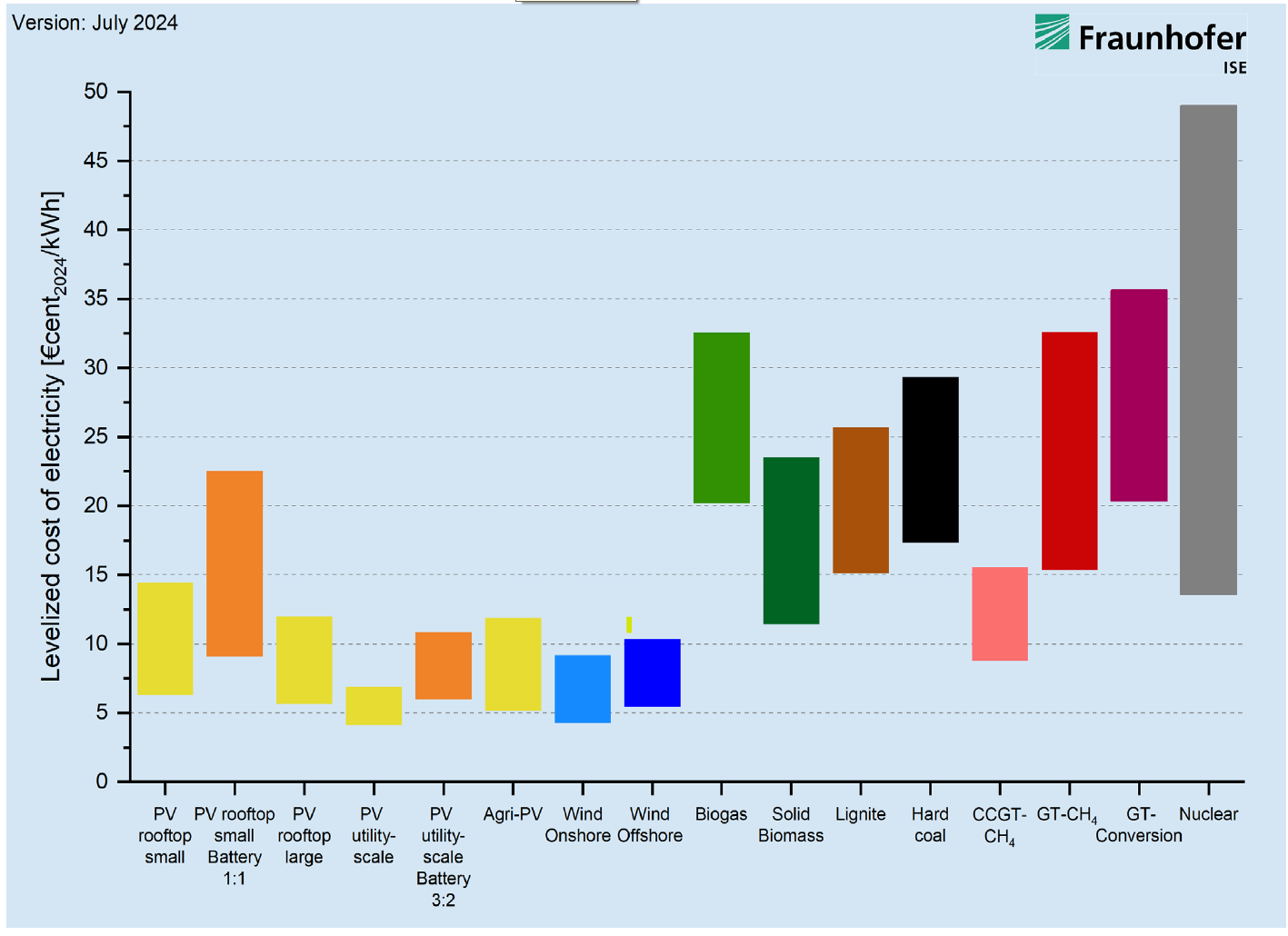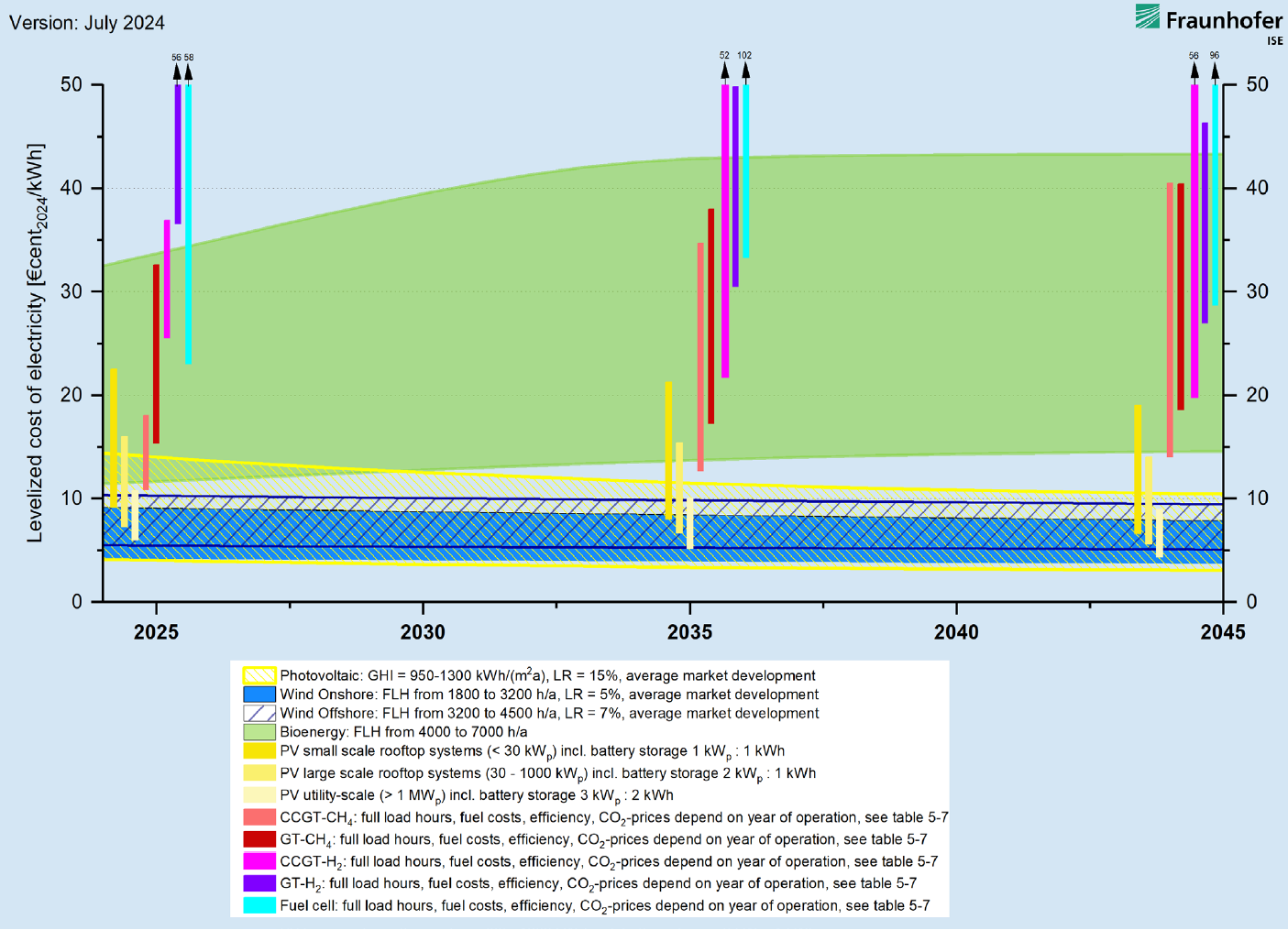Press Release #20
Photovoltaic Plants with Battery Cheaper than Conventional Power Plants
The newest edition of the study by the Fraunhofer Institute for Solar Energy Systems ISE on the electricity generation costs of various power plants shows that photovoltaic systems now produce electricity much more cheaply than either coal or gas-fired power plants, even in combination with battery storage. Fraunhofer ISE has been calculating the so-called electricity generation costs (LCOE), the average generation costs per kilowatt hour of electricity, for Germany at regular intervals since 2010. For the first time, the new analysis also includes the LCOE for agrivoltaics, hydrogen power plants and new nuclear power plants. In addition to the current situation for 2024, the researchers also provide a forecast for cost trends up to 2045.


According to the study's calculations, ground-mounted PV systems and onshore wind turbines with costs of 4.1 to 9.2 cents per kilowatt hour are the most cost-effective technologies in Germany, not only among the renewable energies, but among all types of power plants. The levelized cost of electricity (LCOE) for PV battery systems varies between 6.0 and 22.5 cents per kilowatt hour in the analysis for Germany. This wide range is due to the large cost differences for battery systems, from 400 to 1000 euros per kilowatt hour, in combination with the cost differences for PV systems and the varying levels of solar irradiation at the system location.
"These calculations show that the large-scale projects currently being launched in Germany with a combination of ground-mounted PV systems, wind farms and stationary battery energy storage are good investments," says Dr. Christoph Kost, Head of Department for Energy System Analysis at Fraunhofer ISE and lead author of the study. "The combination of systems allows grid capacities to be better utilized, for example."
LCOE for renewables will continue to fall until 2045
For all power plant technologies, the research team considered the cost trends for the construction and operation of the systems up to 2045, according to which the LCOE for small PV rooftop systems in 2045 will be between 4.9 and 10.4 cents per kilowatt hour and between 3.1 and 5.0 cents per kilowatt hour for ground-mounted PV systems. "Even small PV battery systems could achieve electricity production costs between 7 and 19 cents per kilowatt hour by then, provided that the prices for battery storage systems fall to the assumed 180 to 700 euros per kilowatt hour," says Dr. Verena Fluri, researcher at Fraunhofer ISE and co-author of the study.
New wind turbines built in 2045 could produce electricity onshore at a cost of between 3.7 and 7.9 cents per kilowatt hour. Offshore wind turbines also have strong cost reduction potential. The research team expects price improvements for wind energy thanks primarily to a higher number of full-load hours and larger turbines.
Flexible power plants necessary, but with significantly higher electricity generation costs
In a climate-neutral energy system with a large share of renewable energy, flexible and controllable power plants are needed as a back-up in addition to battery storage systems. In the future, biogas and biomass power plants could cover part of the required output. In the study, the electricity generation costs were calculated with flexible operation, i.e. with medium to low full load hours. Results show an LCOE between 20.2 and 32.5 cents per kilowatt hour for biogas. While for solid biomass plants, the LCOE is significantly lower, ranging between 11.5 and 23.5 cents per kilowatt hour.
For a hydrogen-powered combined-cycle gas turbine power plant built in 2030, the study shows an LCOE between 23.6 and 43.3 cents per kilowatt hour for highly flexible operation. The electricity generation costs of flexible technologies are significantly higher than the costs of renewables, as CO2 costs and the procurement of hydrogen are key cost drivers. "We need them as an important supplement; however, their operation will be limited to a minimum," says Paul Müller, also at Fraunhofer ISE and responsible for this part of the study. He considers 1000 to 2000 operating hours in 2045 to be realistic.
Last modified: